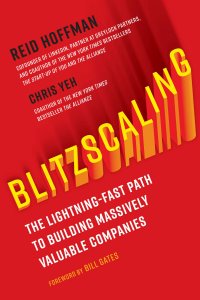Reid Hoffman, co-founder of LinkedIn, looks at how companies can achieve rapid growth and the best way to manage the process
For most of the world, the terms “Silicon Valley” and “startup” have long been synonymous. But Silicon Valley’s dominance as the “home of the startup” is being challenged across the world, and none more so than by China, which has more “unicorns” (startups valued over $1 billion) than any other country.
What is the secret to these startups’ extraordinary success? Contrary to the popular narrative, it’s not their superhuman founders or savvy venture capitalists. According to a new idea it’s because they have learned how to “blitzscale.”
Reid Hoffman is an American venture capitalist, author and entrepreneur, and is best known for being the co-creator of LinkedIn and former chief operating officer of PayPal. He is currently a partner at the leading Silicon Valley venture capital firm Greylock Partners.
Hoffman has written several books, with his most recent being Blitzscaling: The Lightning-Fast Path to Building Massively Valuable Companies, which he co-authored with Chris Yeh. It argues that the secret to starting and scaling massively valuable companies is blitzscaling, a set of techniques for “scaling up at a dizzying pace that blows competitors out of the water.”
In this interview, Hoffman explores blitzscaling in the Chinese context as well as the main factors that determine which startups are set for success and which will crash and burn.
You came up with the term ‘blitzscaling.’ What does it mean?
Blitzscaling is the pursuit of rapid growth by prioritizing speed over efficiency in the face of uncertainty. This approach is the unsung reason that Silicon Valley has created the majority of the world’s most valuable technology companies over the past 25 years, despite a minuscule population of around 4 million people.
What was it that inspired you to write Blitzscaling?
 I’ve heard many people say that the secret to Silicon Valley, or China, is that they are great places to start companies. But the knowledge of how to start a company has been distributed throughout the world, thanks to the internet. The real challenge, and value, comes from being able to scale a company, and little has been written about that important subject. When Chris Yeh and I wrote Blitzscaling, we started by organizing and refining the lessons we had learned from a lifetime of working in Silicon Valley.
I’ve heard many people say that the secret to Silicon Valley, or China, is that they are great places to start companies. But the knowledge of how to start a company has been distributed throughout the world, thanks to the internet. The real challenge, and value, comes from being able to scale a company, and little has been written about that important subject. When Chris Yeh and I wrote Blitzscaling, we started by organizing and refining the lessons we had learned from a lifetime of working in Silicon Valley.
But the more we explored the concepts of blitzscaling, the more we realized that the story of lightning-fast growth was incomplete without including the lessons and stories of scaling in China. That is why our book opens with the story of WeChat’s launch as well as with the story of Airbnb’s decision to blitzscale, why China is the only place in the world that gets its own chapter, and why we’ve dubbed China “the land of blitzscaling.”
Some say that China’s current tech business model of going for scale first, regardless of revenue or profitability, sounds very much like how Silicon Valley operated 20 years ago. Is it a valid approach?
Blitzscaling says that it makes sense to prioritize speed and scale ahead of revenue or profitability when pursuing the leadership of a valuable winner-take-most market. The approach is valid as long as those market dynamics apply. That was true in Silicon Valley 20 years ago, and is true in China and Silicon Valley today.
But while Silicon Valley practices rapid scaling in some unique and amazing ways, China is the place outside of Silicon Valley where I’ve learned the most powerful blitzscaling techniques. Why China? Like the United States, China offers a large domestic market, which allows native blitzscalers to build substantial scale and momentum before taking on the challenge of globalization. But there are ways in which China is a superior environment for blitzscaling.
For example, China’s population and education system result in an abundance of skilled labor and technology experts. In areas like robotics and artificial intelligence, China is probably ahead of the rest of the world. But perhaps the strongest factor is China’s culture of speed. All of this combined results in some of the world’s most stunning examples of blitzscaling.
The dedication of Chinese entrepreneurs to extreme speed results in a pace of work that makes Silicon Valley’s “internet time” workaholics look slow.
How did learning about China shape your business mindset?
In launching LinkedIn China, I had the honor and delight to learn about the Chinese approach to blitzscaling from world-class Chinese entrepreneurs, executives and investors. Sadly, this is something that few in Silicon Valley get a chance to experience. The people I met in China invest a lot of energy into learning from what goes in Silicon Valley, but few entrepreneurs from Silicon Valley or around the world invest the same energy into learning from the Chinese. This is a huge missed opportunity.
When I travel and speak in China, I find that most of the members of my audiences are familiar with the latest developments in Silicon Valley. Most Chinese executives speak and read English and are reading the latest English-language news on a daily basis. How many American or European executives read Chinese and are staying abreast of developments in China?
When Western entrepreneurs wait for an innovation to make its way into the English-language press, perhaps because a Silicon Valley company has started rolling it out, China’s blitzscalers have already built a major advantage using a one-year head start on the global market.
The past 20 years has seen enormous dynamic change, largely generated by the internet, as you mentioned. To what extent do you think change will continue on the same trajectory in the years to come?
The internet revolution has been going strong for nearly 25 years, with no signs of slowing down. I believe the trajectory will be the same or even faster in the future.
What are some examples of companies that have successfully ‘blitzscaled’?
Consider Tencent’s WeChat service, which is probably the most interesting communications tool in the world.
Fast Company called WeChat “China’s app for everything,” and the Financial Times reported that more than half of its users spend over 90 minutes a day using the app. To put WeChat in an American context, it’s as if one single service combined the functions of Facebook, WhatsApp, Facebook Messenger, Venmo, Grubhub, Amazon, Uber, Apple Pay, Gmail, and even Slack into a single megaservice. You can use WeChat to do run-of-the-mill things like texting and calling people, participating in social media, and reading articles, but you can also book a taxi, buy movie tickets, make doctors’ appointments, order dinner for the night, pay your rent, play games, send money to friends, plus so much more. All from a single app on your smartphone.
Yet what’s even more amazing was the speed and aggressiveness with which WeChat grew. Pony Ma authorized the WeChat project after a single late-night phone call. Two months later, starting from scratch, a small internal team launched WeChat. Fourteen months after that, WeChat registered its 100 millionth user. WeChat is a testament to the power of rapid, decisive action.
Another amazing blitzscaler is Xiaomi, and its founder Lei Jun. Xiaomi has an innovative business model where it sells its smartphones at cost as a distribution strategy to build a powerful platform. It then monetizes the software that runs on the platform, as well as the very profitable business of selling accessories to its smartphones and other core hardware products.
Xiaomi achieves its results thanks in part to a relentless approach that makes Silicon Valley seem soft. Lei Jun told me, “You American entrepreneurs are lazy. The vast majority of my company is still working at 9 o’clock on a Saturday night.” In some ways, he’s right. Chinese blitzscalers work with an intensity that few in Silicon Valley can match. Rather than staying open during the standard American business hours of 9 a.m. to 5 p.m., Xiaomi operates on a “996” model—get in at 9 a.m., leave the office at 9 p.m., and work six days a week.
I saw the same thing at LinkedIn China. To make a tight deadline for our “Red Horse” project, our China team leader Derek Shen simply moved the entire development team to a hotel for two weeks so that its members could work around the clock without any of the distractions of normal life.
What are the main factors that differentiate between startups that are set for success and those that crash?
In my book, Blitzscaling, we lay out four key growth factors and two key growth limiters that describe successful companies. The successful companies that are tackling large markets, can tap into high scalable distribution channels, sell a high-margin product and leverage network effects or other user lock-in to win a winner-take-most market. In addition, to sustain their growth, they need to have achieved product-market fit, and have a way to solve the challenges of operational scalability.
What is there for Western tech companies to learn from the development and operational models of China tech companies?
Wise entrepreneurs can learn about emerging business models by observing what emerges from the feverishly competitive and experimental markets in China. Many business model innovations that have enabled new blitzscaling businesses have started either in China, or more broadly in Asia, such as the dizzying rise of digital goods. Any non-Chinese entrepreneur with plans to innovate in areas like mobile payments and consumer robotics ought to learn to read Chinese, or face starting the race to blitzscale with a multi-lap handicap.
Chinese leaders and entrepreneurs should be proud of the amazing advances that they’ve achieved. But I hope that they will also find in Blitzscaling some valuable lessons on alternate ways to scale and manage growth. The biggest opportunity is for Silicon Valley and China to work together and combine their respective strengths. According to Andrew Ng, it took a combination of ideas from both sides of the Pacific to drive breakthrough progress in speech recognition. Silicon Valley companies like Nvidia provided the graphical processor units (GPUs) to power machine learning networks, while progress came from combining Silicon Valley’s expertise in GPU programming with China’s expertise in supercomputing.
There is no telling what kind of wealth and progress might emerge out of future collaboration between the leading innovators in these two ecosystems.
When it comes to starting a new company, what are the opportunities and challenges like now compared to when you first started doing it?
In comparison to the late 1990s, the infrastructure to build companies is much more effective and efficient, ranging from tools like AngelList for raising capital to Amazon Web Services for operating a massively scalable product. The challenge is that more competitors (and potential competitors) exist than at any other time in history. The would-be blitzscaler needs to sprint much faster than 20 years ago.
How does China’s Greater Bay Area and Silicon Valley compare when it comes to innovation and opportunities in the startup world?
China and Silicon Valley share a number of key strengths, including a massive domestic market, highly educated workforce, and ready access to capital for blitzscaling. One of the areas in which China has rapidly closed the gap with Silicon Valley is in the supply of executives with blitzscaling experience; the success of companies like Alibaba and Tencent have educated a cadre of capable executives and potential founders. Meanwhile, China also has a number of advantages over Silicon Valley, including its strength in manufacturing, and a much larger labor pool.

















